|
Stoke-on-Trent – the Potteries – has
always had bad press. Priestley commented that the human race had
yet to arrive here in the 1930s. Pevsner famously described the six
towns, or five towns as both he and Bennett christened the city, an
“urban tragedy”. In the swinging sixties, then Government minister
Richard Crossman felt that the place ought to be abandoned and that
any attempts at ‘urban renewal’ would be a huge waste of time and
money. In recent times, Stoke-on-Trent has been named the worst place
in the country to live. Are such views accurate, or is the place and
its unique qualities simply misunderstood?
The prevailing image of
the Potteries to those from farther a field is that of pits and
pots, and smoke and stench, in spite of the fact that the pits have
gone, the pottery industry has changed beyond all recognition, and
the city now has one of the greenest urban landscapes in the country
thanks to its Victorian parks and award-winning land reclamation
programmes. Stoke-on-Trent has always thought to have been in need
of ‘cleaning up’, and ridding the city of her smoke and grime
generating potbanks has been a part of the on going clean up. Never
mind the beauty of the potbanks’ products. Never mind the beauty of
the buildings themselves. Never mind that reuse of existing
buildings can often prove more sustainable than clearance and
redevelopment.
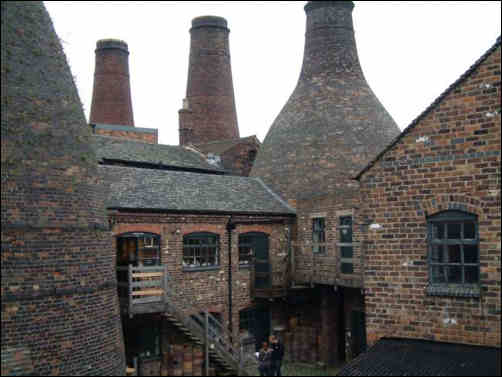
Gladstone Pottery Museum: the classic potworks, and one of the first to be restored
Over the past couple of decades
there has been a much greater appreciation of industrial heritage and
architecture, from the huge dockland warehouses of Liverpool and the
east end of London, to the famous Lancashire cotton mills. Great
examples of this appreciation include the reuse of the Sir Alfred
Bird’s Custard Factory in Birmingham, the resurgence of Ancoats in
Manchester, and the transformation of the Great Western Railway
Engineering Works in Swindon. The Potteries has its own abundance of
such heritage in its potbanks, yet there has not been the emphasis on
reuse and restoration as in other industrial cities. Why is this so?
The seeds of such
apathy towards the Potteries have probably been sown by the potters
themselves; in 1991, the Royal Commission on the Historical
Monuments of England published Potworks, an overview of the
city’s industrial architecture, which detailed many images and
descriptions of beautiful, long gone potbanks such as the Hill
Pottery in Burslem, and Fenton’s Foley Potteries, pulled down by
companies looking to yield value from cleared sites while moving
operations to other locations in cheaper, easier to maintain
buildings of little art or character, with such activity supported,
and in some cases encouraged, by former and current civic
dignitaries who ought to hang their heads in shame. Some of the
buildings referred to in Potworks – while around at the time
of publication – have long since gone.
I understand the
arguments of outdated facilities, and modernisation of processes,
but if the people of the Potteries cannot appreciate and respect the
city’s industrial heritage and architecture, how can we expect the
profit-hungry monsters of the development industry to do the same?
Indeed, Stoke-on-Trent as a city is undervalued in terms of its
architecture and heritage (and not just industrial architecture),
with just 192 Listed Buildings. Given the city’s size in terms of
population, and its rich industrial history, this is a great shame.

|
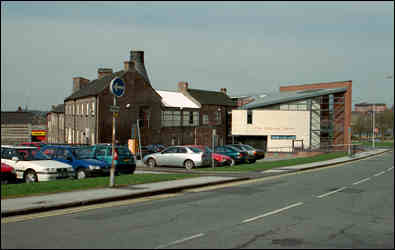
Dudson Centre,
Hanover Street, Hanley
There
have been some great examples of a positive approach to reuse of
potbanks though.
Hulme Upright
Manning of Festival Park have brilliantly restored the Dudson Pottery
works on Hanover Street in Hanley, including some well executed modern
interventions, to create the Dudson Centre, which houses the Dudson
Museum, conference facilities, and provides office accommodation for
local voluntary services.
This is arguably Hulme Upright Manning’s most impressive work in
years.
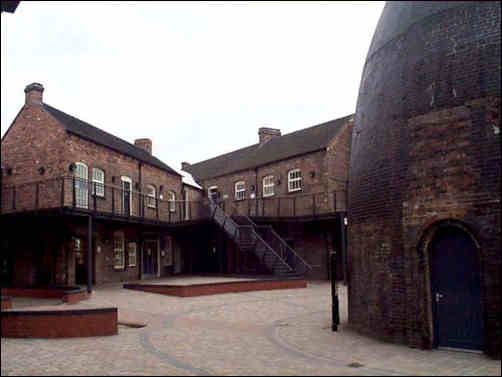
The courtyard and bottle kilns of the Dudson
Centre |

|
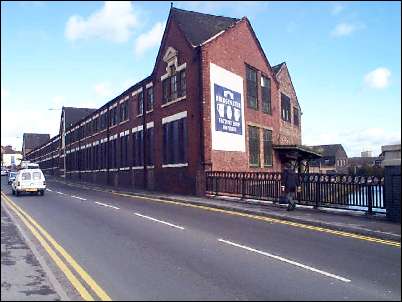
The soon to be transformed Eastwood Pottery
-photo 1999-
The much maligned housing market
renewal pathfinder, RENEW North Staffordshire, has taken a cue
from other major cities, and include in their vision to
rejuvenate the area, plans to reuse the Eastwood Pottery on
Lichfield Street, Hanley as part of the new canalside community,
City Waterside.
RENEW also plan to create much
needed space for small businesses at Atlas Works in Shelton.
However, cynics may suggest that this is a tokenistic gesture to
pacify those accusing them of ignorance of the importance of
some of the city’s housing stock. |
This is the good news.
Other potbanks may not be so lucky. Arguably the potbank with the
finest frontage is Boundary Works on the edge of Longton. Its Grade II
Listing may save it from the usual clearance approach, but unless the
local authority utilises its statutory powers in terms of forcing
repairs, this impressive building may yet disappear through
deterioration and neglect.
The historic Spode site
on Church Street in Stoke, possibly the oldest surviving largest
pottery manufactory’s in the city, and a great example of a potbank
that has grown organically as opposed to have been planned, could be
considered ‘under threat’ from major redevelopment.
Other potbanks at risk
from either ‘comprehensive regeneration’ or neglect include the former
Royal Doulton site on Nile Street, Burslem (owned by ‘regeneration
specialist’ St Modwen, not known as classic restoration experts), the
Falcon Pottery on Old Town Road, Hanley, and Portmeirion’s Falcon
Works on Sturgess Street in Stoke.
David Proudlove 12
December 2007

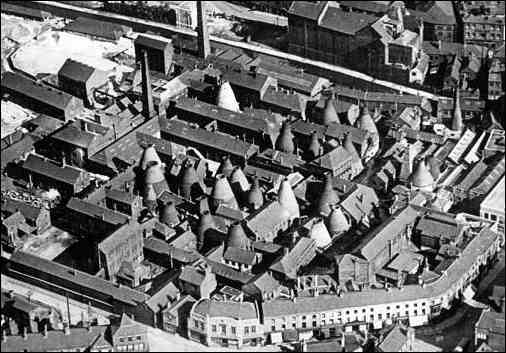
Aerial view of Spode China Works, Church Street,
Stoke, 1927
-click for larger picture-
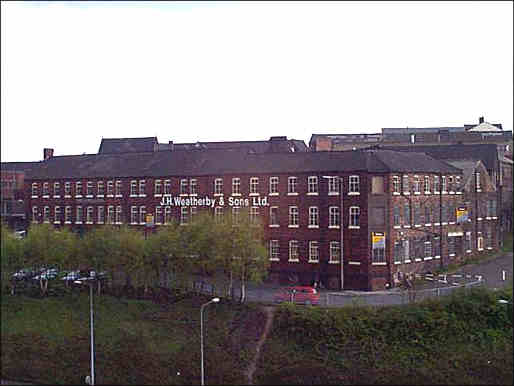
Falcon Pottery of J H
Weatherby & Sons, Old Town Road, Hanley
-click for
more on Weatherby-

The frontage of the
Boundary Works, King Street, Longton
|
![]()
![]()
![]()